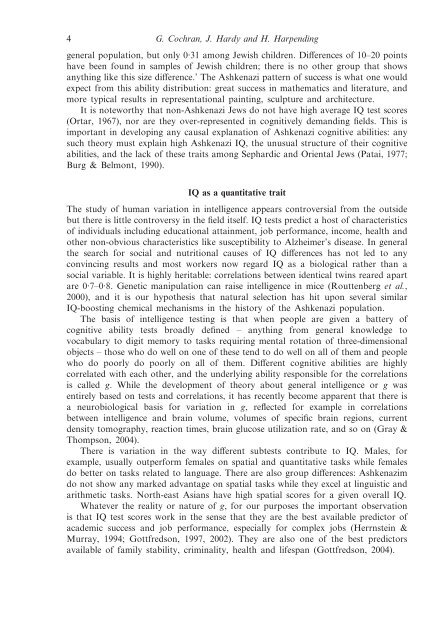natural history of ashkenazi intelligence - Henry C Harpending ...
natural history of ashkenazi intelligence - Henry C Harpending ...
natural history of ashkenazi intelligence - Henry C Harpending ...
You also want an ePaper? Increase the reach of your titles
YUMPU automatically turns print PDFs into web optimized ePapers that Google loves.
4 G. Cochran, J. Hardy and H. <strong>Harpending</strong><br />
general population, but only 0·31 among Jewish children. Differences <strong>of</strong> 10–20 points<br />
have been found in samples <strong>of</strong> Jewish children; there is no other group that shows<br />
anything like this size difference.’ The Ashkenazi pattern <strong>of</strong> success is what one would<br />
expect from this ability distribution: great success in mathematics and literature, and<br />
more typical results in representational painting, sculpture and architecture.<br />
It is noteworthy that non-Ashkenazi Jews do not have high average IQ test scores<br />
(Ortar, 1967), nor are they over-represented in cognitively demanding fields. This is<br />
important in developing any causal explanation <strong>of</strong> Ashkenazi cognitive abilities: any<br />
such theory must explain high Ashkenazi IQ, the unusual structure <strong>of</strong> their cognitive<br />
abilities, and the lack <strong>of</strong> these traits among Sephardic and Oriental Jews (Patai, 1977;<br />
Burg & Belmont, 1990).<br />
IQ as a quantitative trait<br />
The study <strong>of</strong> human variation in <strong>intelligence</strong> appears controversial from the outside<br />
but there is little controversy in the field itself. IQ tests predict a host <strong>of</strong> characteristics<br />
<strong>of</strong> individuals including educational attainment, job performance, income, health and<br />
other non-obvious characteristics like susceptibility to Alzheimer’s disease. In general<br />
the search for social and nutritional causes <strong>of</strong> IQ differences has not led to any<br />
convincing results and most workers now regard IQ as a biological rather than a<br />
social variable. It is highly heritable: correlations between identical twins reared apart<br />
are 0·7–0·8. Genetic manipulation can raise <strong>intelligence</strong> in mice (Routtenberg et al.,<br />
2000), and it is our hypothesis that <strong>natural</strong> selection has hit upon several similar<br />
IQ-boosting chemical mechanisms in the <strong>history</strong> <strong>of</strong> the Ashkenazi population.<br />
The basis <strong>of</strong> <strong>intelligence</strong> testing is that when people are given a battery <strong>of</strong><br />
cognitive ability tests broadly defined – anything from general knowledge to<br />
vocabulary to digit memory to tasks requiring mental rotation <strong>of</strong> three-dimensional<br />
objects – those who do well on one <strong>of</strong> these tend to do well on all <strong>of</strong> them and people<br />
who do poorly do poorly on all <strong>of</strong> them. Different cognitive abilities are highly<br />
correlated with each other, and the underlying ability responsible for the correlations<br />
is called g. While the development <strong>of</strong> theory about general <strong>intelligence</strong> or g was<br />
entirely based on tests and correlations, it has recently become apparent that there is<br />
a neurobiological basis for variation in g, reflected for example in correlations<br />
between <strong>intelligence</strong> and brain volume, volumes <strong>of</strong> specific brain regions, current<br />
density tomography, reaction times, brain glucose utilization rate, and so on (Gray &<br />
Thompson, 2004).<br />
There is variation in the way different subtests contribute to IQ. Males, for<br />
example, usually outperform females on spatial and quantitative tasks while females<br />
do better on tasks related to language. There are also group differences: Ashkenazim<br />
do not show any marked advantage on spatial tasks while they excel at linguistic and<br />
arithmetic tasks. North-east Asians have high spatial scores for a given overall IQ.<br />
Whatever the reality or nature <strong>of</strong> g, for our purposes the important observation<br />
is that IQ test scores work in the sense that they are the best available predictor <strong>of</strong><br />
academic success and job performance, especially for complex jobs (Herrnstein &<br />
Murray, 1994; Gottfredson, 1997, 2002). They are also one <strong>of</strong> the best predictors<br />
available <strong>of</strong> family stability, criminality, health and lifespan (Gottfredson, 2004).


